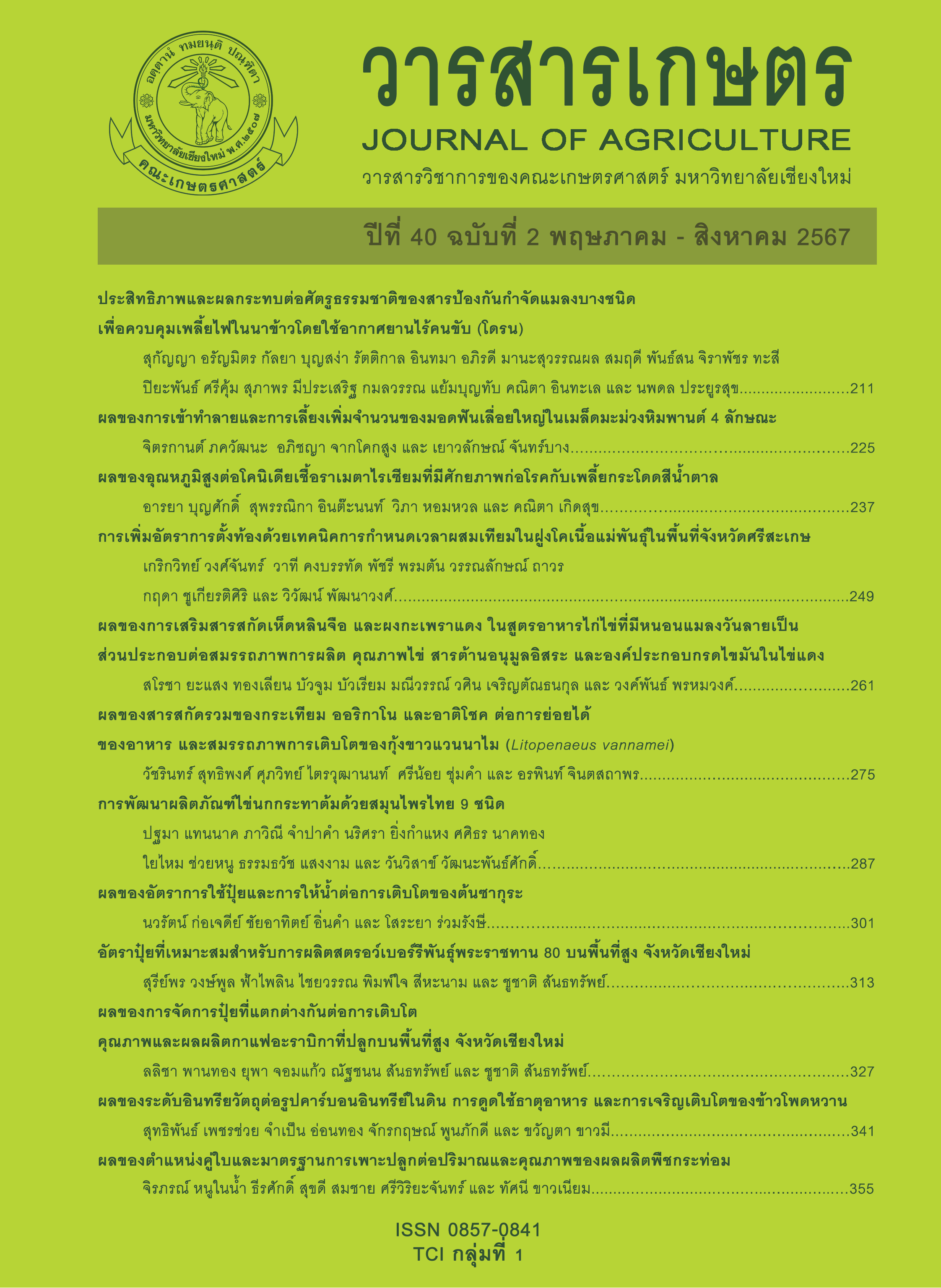ผลของอัตราการใช้ปุ๋ยและการให้น้ำต่อการเติบโตของต้นซากุระ
Main Article Content
บทคัดย่อ
ซากุระ (Prunus serrulata) เป็นไม้ยืนต้นที่มีความสำคัญในประเทศญี่ปุ่น ปัจจุบันประเทศไทยมีการนำเข้าต้นซากุระจากต่างประเทศมาปลูกในพื้นที่สูงเพื่อส่งเสริมการท่องเที่ยวเชิงเกษตร อย่างไรก็ตามข้อมูลเกี่ยวกับการปลูกซากุระในประเทศไทยยังมีจำกัด งานวิจัยนี้จึงมีวัตถุประสงค์เพื่อศึกษาอัตราการให้ปุ๋ย และการให้น้ำที่เหมาะสมต่อการเติบโตและการเปลี่ยนแปลงทางสรีรวิทยาของต้นซากุระ วางแผนการทดลองแบบแฟคทอเรียลในสุ่มสมบูรณ์ขนาด 4x3 กรรมวิธีละ 5 ซ้ำ ประกอบด้วยปัจจัยที่ 1 คือ ความถี่การให้น้ำ จำนวน 4 แบบ ได้แก่ 1) ให้น้ำทุกวัน 2) ให้น้ำทุก 2 วัน 3) ให้น้ำทุก 4 วัน และ 4) ให้น้ำสัปดาห์ละ 1 ครั้ง โดยให้พืชได้รับน้ำ 1 ลิตรต่อครั้งต่อต้น และ ปัจจัยที่ 2 คือ อัตราการให้ปุ๋ย จำนวน 3 ระดับ ได้แก่ 1) ไม่ใส่ปุ๋ย 2) ใส่ปุ๋ย 15-15-15 (N-P2O-K2O) อัตรา 5 กรัม/กระถาง และ 3) ใส่ปุ๋ย 15-15-15 (N-P2O-K2O) อัตรา 10 กรัม/กระถาง บันทึกข้อมูล ด้านความสูงของต้น (เซนติเมตร) จำนวนกิ่งต่อต้น (กิ่ง) ความยาวกิ่ง (เซนติเมตร) อัตราการสังเคราะห์แสง (µmol m-2s-1) การเปิดปากใบ (mol m-2s-1) และการคายน้ำของพืช (mmol m-2s-1) ผลการทดลองพบว่า เดือนที่ 4 หลังให้กรรมวิธีทดลอง อัตราการให้ปุ๋ย และความถี่การให้น้ำ ไม่มีผลต่อการเติบโตของซากุระ ในด้านความสูงของต้น จำนวนกิ่งต่อต้น และความยาวกิ่ง นอกจากนี้ยังพบว่าไม่มีปฏิกิริยาสัมพันธ์ระหว่างปัจจัยอีกด้วย ส่วนผลด้านการเปลี่ยนแปลงสรีรวิทยาพบว่า การให้น้ำสัปดาห์ละครั้งมีผลต่อค่าเฉลี่ยการคายน้ำสูงสุดคือ 1.99 mmol m-2s-1 อย่างไรก็ตามพบว่าปฏิกิริยาสัมพันธ์ร่วมระหว่างปัจจัยมีผลต่อค่าเฉลี่ยของการเปิดปากใบ และการคายน้ำของพืช
Article Details

อนุญาตภายใต้เงื่อนไข Creative Commons Attribution-NonCommercial-NoDerivatives 4.0 International License.
เอกสารอ้างอิง
Asma, B.M., S. Colak, Y. Akca and C. Genc. 2007. Effect of fertilizer rate on the growth, yield and fruit characteristics of dried apricot (cv. Hacihaliloglu). Asian Journal of Plant Sciences 6(2): 294 - 297.
Banon, S., J.A. Fernandez, J.A Franco, A. Torrecillas, J.J. Alarcón and M.J. Sánchez-Blanco. 2004. Effects of water stress and night temperature preconditioning on water relations and morphological and anatomical changes of Lotus creticus plants. Scientia Horticulturae 101(3): 333-342.
Benlloch-González, M., O. Arquero, J.M. Fournier, D. Barranco and M. Benlloch. 2008. K+ starvation inhibits water stress induced stomatal closure. Journal of plant physiology 165(6): 623-630.
Brag, H. 1972. The Influence of Potassium on the Transpiration Rate and Stomatal Opening in Triticum aestivum and Pisum sativum. Physiologia Plantarum 26(2): 250-257.
Hatfield, J.L., T.J. Sauer and J.H. Prueger. 2001. Managing soils to achieve greater water use efficiency: a review. Agronomy Journal. 93(2): 271-280.
Inoti, S.K. and D. Cherop. 2022. Appropriate watering interval for Prunus africana nursery seedlings in Egerton University, Njoro, Kenya. International Journal of Science and Research Update 3(01): 034-039.
Jiang, D., X. Shen and B. Shen. 2022. Prunus conradinae ‘Luoshifener’, a Flowering Cherry Cultivar with a Strong Aroma. HortScience 57(11): 1473-1474.
Kaweeta, L., M. Na-Nakhon, S. Suwanwong and S. Tantiwiwat. 2009. Plant Physiology. 2nd ed. Kasetsart University, Bangkok. 261 p. (in Thai)
Kuitert, W. and A.H. Peterse. 1999. Japanese Flowering Cherries. Timber Press, Portland, Oregon. 436 p.
Ky-Dembele, C., J. Bayala, P. Savadogo, M. Tigabu, P.C. Odén, I.J. Boussim, B. Ky-Dembele, C. Bayala, P. Tiguba and P.C Boussim. 2010. Comparison of growth responses of Khaya senegalensis seedlings and stecklings to four irrigation regimes. Silva Fennica 44(5): 787-798.
Wang, L.L., J.A. Palta, W. Chen, Y.L. Chen and X.P. Deng. 2018. Nitrogen fertilization improved water-use efficiency of winter wheat through increasing water use during vegetative rather than grain filling. Agricultural Water Management 197: 41-53.
Martínez-García, P.J., J. Hartung, F. Pérez de los Cobos, P. Martinez-Garcia, S. Jalili, J.M. Sanchez-Roldan, M. Rubio, F. Dicenta and P. Martinez-Gomez. 2020. Temporal response to drought stress in several prunus rootstocks and wild species. Agronomy 10(9): 1383, doi.org/10.3390/agronomy10091383.
Pascual, M., J. Lordan, J.M. Villar, F. Fonseca and J. Rufat. 2013. Stable carbon and nitrogen isotope ratios as indicators of water status and nitrogen effects on peach trees. Scientia Horticulturae 157(7): 99-107.
Rutkowski, K. and G.P. Lysiak. 2023. Effect of nitrogen fertilization on tree growth and nutrient content in soil and cherry
leaves (Prunus cerasus L.). Agriculture 13(3): 578, doi: 10.3390/agriculture13030578.
Scagel, C.F., G. Bi, L.H. Fuchigami and R.P. Regan. 2011. Effects of irrigation frequency and nitrogen fertilizer rate on water stress, nitrogen uptake, and plant growth of container-grown rhododendron. Hort Science 46(12): 1598-1603.
Scheiber, S.M., E.F. Gilman, M. Paz, and K.A. Moore. 2007. Irrigation affects landscape establishment of Burford holly, pittosporum, and sweet viburnum. HortScience 42(2): 344-348.
Shaw, B., T.H. Thomas and D.T. Cooke. 2002. Responses of sugar beet (Beta vulgaris L.) to drought and nutrient deficiency stress. Plant Growth Regulation 37: 77-83.
Shober, A.L., K.A. Moore, C. Wiese, S.M. Scheiber, E.F. Gilman, M. Paz and S. Vyapari. 2009. Posttransplant irrigation frequency affects growth of container-grown sweet viburnum in three hardiness zones. HortScience 44(6): 1683-1687.
Sruamsiri, P. 2011. Mineral Nutrient for horticulture crop production. Wanida Karnpim, Chiang Mai. 326 p. (in Thai)
Zhang, Y.Q., J.D. Wang, S.H. Gong, D. Xu and J. Sui. 2017. Nitrogen fertigation effect on photosynthesis, grain yield and water use efficiency of winter wheat. Agric Water Manage 179: 277-287.


